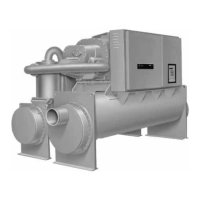38 RLC-SVN005B-EN
Quick Start, Initial Parameters
Important: This chapter is only applicable for Trane
starter software. It DOES NOT apply to MX2
STANDARD software starter. See
Programming Guide RLC-SVP01*-EN for
more information.
Prior to Unit Power Up
NOTICE
Compressor Motor Damage!
Disconnect all electric power including remote
disconnects prior to evacuating refrigeration.
System power shall not be applied to the chiller
while the refrigerant system is in a vacuum.
Failure to disconnect power prior to evacuating
th
e refrigerant system, or application of
power
while the refrigerant system is in a vacuum, will
cause compressor motor damage due to the
nature of the solid state starter.
Do NOT energize the unit if the refrigerant side of the
system is in a vacuum.
The Benshaw Solid State Starter is an “in-the-delta”
starter. The starter
leads and motor leads are always
energized. Catastrophic damage to the compressor motor
will occur if supply power is applied while the system is in
a vacuum.
Programming UCP2 or CH530 Controller
WARNING
Hazardous Voltage w/Capacitors!
Disconnect all electric power, including remote
disconnects and discharge all motor start/run capacitors
before servicing. Follow proper lockout/tagout
procedures to ensure the power cannot be inadvertently
energized. For variable frequency drives or other energy
storing components provided by Trane or others, refer to
the appropriate manufacturer’s literature for allowable
waiting periods for discharge of capacitors. Verify with
an appropriate voltmeter that all capacitors have
discharged. Failure to disconnect power and discharge
capacitors before servicing could result in death or
serious injury.
For additional information regarding
the safe discharge
of capacitors, see PROD-SVB06A-EN.
After the new starter is installed, the UCP2 or CH530
controller needs to be programmed.
• Programming of UCP2 or CH530 controller:
• D
isable the “Phase Reversal Protection” for proper
unit o
peration. Phase reversal and phase loss
protection is built into the Benshaw Redistart
controller.
Programming Benshaw Starter
The Benshaw controller on the solid state starter also
needs to be programmed.
Note: Below is a limited guide for programming the
Benshaw starter
. See RTHD-SVD02*-EN for further
details on programming and troubleshooting the
Benshaw starter.
In order for the starter to operate properly, the following
p
aramete
rs need to be validated before the starter can
correctly start a motor. For the range of parameters, see
parameter settings in Table 1, p. 39 and “CT Switch
Settings,” p. 40.
P1 Motor FLA
This parameter configures the motor full load amps, and
is obtained from the nameplate on the attached motor.
Note: Incorrectly setting this parameter will affect
proper
operation of the motor overload protection, motor
over current protection, motor undercurrent
protection, ground fault protection and
acceleration control.
To set P1, start with the chiller RLA. If acceleration on
start-
up is slug
gish, gradually increase the P1 setting. Do NOT
exceed the RLA at Max kW. The unit RLA at max kW can be
found in the product catalog or on the unit nameplate.
P2 Maximum Motor Current
The maximum current parameter is set as a percentage of
the motor FLA parameter setting. The maximum current
parameter performs two functions. It sets the current level
for the end of the ramp profile. It also sets the maximum
current that is allowed to reach the motor after the ramp is
completed. the maximum motor current is set to 260%
from the factory.
If the ramp time expires before the motor has rea
ched full
speed, the starter will hold the current at the maximum
current level until the UTS timer expires, the motor
reaches full speed, or the overload trips.
Note: If faster accelerati
on i
s desired, the setting can be
increased.
P3 Ramp Time
The ramp time is the time it takes for the starter to allow the
current to go from the initial current to the maximum
current. To make the motor accelerate faster, decrease the
ramp time. To make the motor accelerate slower, increase
the ramp time.
The ramp time is set to 1 second from the
factory.
If th
e ramp time expires before the motor reaches full
speed, the starter will
maintain the set maximum current

